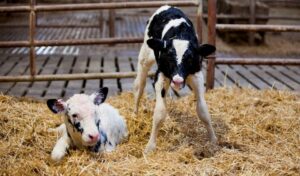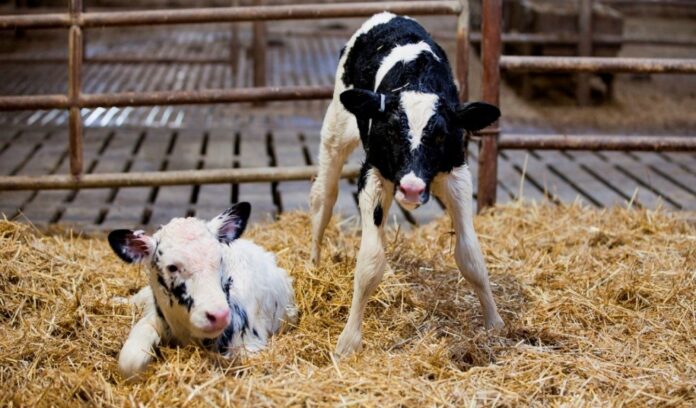CARE AND MANAGEMENT OF NEWBORN CALF
Dr. Surya Kant1, Dr. Pramod Kumar2, Dr. K. D. Singh3 and Dr. A. K. Verma3
1PG Scholar, Department of Livestock Production Management
2Assistant Professor, Department of Veterinary Physiology & Biochemistry
3Assistant Professor, Department of Livestock Farm Complex
College of Veterinary Science & Animal Husbandry, ANDUAT, Kumarganj, Ayodhya, U.P.
Calves are crucial to the growth of the nation’s dairy industry because the future of the dairy herd is totally dependent on the proper rearing of young calves. In particular, female calves are preserved for herd replacement. When they are sold, the male calves are often kept up until weaning. Calf care is crucial for both the survival of the dairy business and the preservation and maintenance of our high-quality genetic material. Calves may die from diseases like pneumonia, calf scours, navel infections, and worm infestations (Ascariasis), as well as from under or overfeeding. These conditions can reduce calf mortality to less than 10% with proper care.
The golden hour: The most crucial time in a newborn calf’s entire existence occurs within the first hour of calving.
Care of calf and cow at birth
- Cows should be moved to separate calving pens a few days or ideally a week or two before the estimated calving date, depending on the likelihood that they will give birth.
- The number of breedable cows and heifers, typically 5% of this number, determines the amount of calving pens needed on a farm.
- It’s possible to provide sufficient bedding, laxative feed, and water in ample quantities.
- Prior to bringing in the cow, the calving pen should be meticulously cleaned and sterilized.
- The cow should not be tethered too closely; instead, it should be secured with enough rope to allow the animal to roam around freely and care for the calf without being seen when giving birth at night.
Calving Pen
It is an individual loose box or stall used for calving, which should be 3×4 m size (12 m2) and well ventilated. Sufficient lighting is essential. It provides better protection to the cow and calf and avoids disturbances from other cows.
Management immediately after calving
Following parturition, the cow will often lick and dry the calf, which may promote cutaneous blood circulation and respiration. The udder and hindquarters should be rinsed with lukewarm water diluted with potassium permanganate lotion’s antiseptic solution, then dried with a clean cloth. Primiparous cows occasionally exhibit nervousness and inexperience, or they may get exhausted after an extended labor. In such cases, a dry towel should be used to wipe and clear the mucus (phlegm) from the newborn calf’s nostrils. The breathing of the calf may be hampered by a mucus-filled respiratory passage. To allow the phlegm to drain, the calf should be elevated in this situation by holding the hock with the head down. Lifting the calf requires caution because it could come off. To maintain a hold, use a handful of straw or a fresh towel. A twig of hay or dry grass can be tickled inside the nostrils to get the calf to sneeze. It is possible to milk cows to release the strain on their udders. After delivery, the placenta should be eliminated within 12 to 24 hours. Ask a veterinarian for assistance if it is not eliminated within 24 hours or can not be removed unaided (manually).
The person providing care should put his mouth to the newborn calf’s nostrils and suck away the mucus. He should then close the calf’s mouth and breathe in his exhaled air via its nostrils. Carbon dioxide from the calf’s exhaled air has been sucked up by its lungs, acting as a respiratory stimulant to get it to start breathing. This should be followed by irregularly applying and releasing pressure to the calf’s chest wall in order to give artificial breathing.
The naval or umbilical cord should be ligatured with sterile thread, severed 1 to 2 cm distally, and heavily painted with 7% or higher tincture iodine or povidine iodine at a distance of one inch from the body. This is important because infections can easily travel through the naval and produce severe illnesses including joint ill (joint swelling) & naval ill (an abscess of the umbilicus).
There are several processes to feeding during the pre-ruminant period –
- Importance of colostrum feeding
- Whole milk feeding
- Calf starter
- Milk replacer
- Forage feed

Image credit: https://www.hubbardfeeds.com/
Importance of colostrums feeding
- Colostrums are a highly fortified source of nutrition that include twice as much total solids and seven times as much protein as regular milk, giving early boosts to portion and solid intake..
- Within 30 minutes of birth, a healthy normal calf stands up on its own while weaker calves require support. Feeding of colostrum within the first hour of life is essential and should be continued for the first 4 days of life. The calf requires three equal feeding of 3 to 4 liters of colostrum every day. To increase the quantity and quality of immunoglobulin in colostrum, cows must be immunized against infectious and communicable illnesses.
- One tenth of a calve’s body weight worth of colostrums must be given :
- 15-30 minutes of life – 5-8 % of body weight
- 10-12 hours of life – 5-8 % of body weight
- 2nd day – 10% of body weight
- 3rd day – 10% of body weight
- Colostrum is a highly enriched nutritional source and has the following characteristics –
- It provides the newborn calf with passive immunity.
- It has laxative effect which is helpful in expulsion of muconium (first faeces).
- Activity of antitrypsin and subsequent absorption
- It’s enriched with vitamins A, D, and E.
- Excellent economical nutrition for calf calves
- As antimicrobial ingredients, it must to include lysozyme, lactoferrin, and lactoperoxidase.
Whole milk feeding
Whole milk can be fed to calf from 4th day onward @ approximately 10% of body weight at divided doses twice daily for maximum of 2 weeks. To increase growth rate, combine antibiotics and feed supplements into the milk or concentrate. Milk containers, milk buckets/pails and other equipment should be kept sanitized and hygienic. Milk should be boiled and cooled to body temperature (39°C) before feeding. The subsequent allowance should be withheld and the calves may be drenched with 30 to 50 ml of castor oil if they do not consume milk. During the first week, milk should be given three or four times per day; after 90 days, only twice per day should be given. For ascariasis, calves should be dewormed as early as the first week.
Calf starter
Skim milk and calf starter can be used in place of whole milk for a more cost-effective method of calf growing up. Energy is insufficient in skim milk. It is the first solid concentrate that has been enriched with vitamins, minerals, and antibiotics. Starter can be provided as a pellet or coarse feed to encourage early intake, and it should be extremely attractive. Make sure starter has suitable particle size, not too powdered or too dusty, as these circumstances will reduce intake and maintain healthy rumen growth. Beginning in their second week of life, calves begin consuming small quantities of dry starter. A calf starter should be really succulent. It should have high energy content (70% TDN) and 20% crude protein that are digestible. After the calf starts consuming roughly 1-1.5 kg of the starting mix per day, the amount may be regulated. Calf starter can be provided free-choice. Normally, calves reach this stage between the ages of 2 ½ and 3 months. When the calf is ingesting 400–500 gram of concentrate per day, depending on the breed, milk feeding can be stopped.
Composition of calf starter
| INGREDIENTS | PARTS (%) |
| Maize | 42 |
| GNC | 35 |
| Wheat bran or rice bran | 10 |
| Fish meal | 10 |
| Mineral mixture | 2 |
| Salt | 1 |
Milk replacers
Skim milk powder, lard, or vegetable fat make up the majority of milk replacers or substitutes, however butter milk powder and whey powder are frequently used as well. Some minerals and vitamins, as well as a little amount of glucose, soybean flour, and grain flour, may also be included. After the Colostrum feeding, there is no need to feed any whole milk if a high-quality milk replacer is utilized. Common features of high-quality milk replacers –
- Contains minimum 50% spray dried skim milk powder
- Should be readily dispersible in water.
- High-quality milk substitutes frequently include vitamin A, E, and B12 supplements.
- A good milk substitute should be composed of spray-dried skimmed milk powder in the amount of 50 parts, dried whey in the amount of 10 parts, and non-milk sources in the amount of 40 parts.
- The ideal ratio between milk replacer (kg) & water (litre) is 1: 8.
- Incorporated with antibiotic feed additives.
- Should contain 22-25% good quality protein.
- Should not contain starch or fibre.
- Since dilutions that are either too weak or too powerful tend to cause digestive issues, milk substitute should be blended in the right proportion with warm water.
- Should flow easily when made into a powder for automatic feeding machinery.
Forage feed
Young calves can choose from a healthy free-choice source of feed that is clean, leafy green legumes. Forages are a good source of fiber, which promotes the growth of the rumen’s muscular layer and helps to preserve the lining’s integrity. In addition to calf starter, good quality fodder should be offered to assure freshness and encourage intake. To lessen the chance of soiling, feed racks and buckets should be positioned at a level that is comfortable for calves.
References:
- Livestock Production Management- C. K. Thomas & N. S. R. Sastry
- http://www.agritech.tnau.ac.in/
- https://www.pashudhanpraharee.com/


